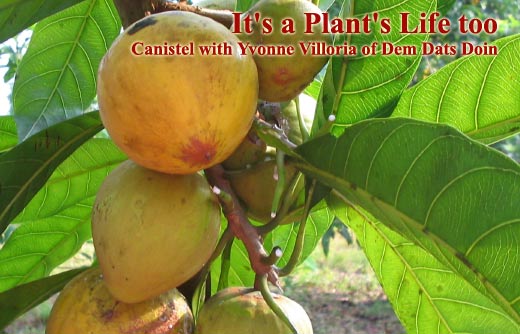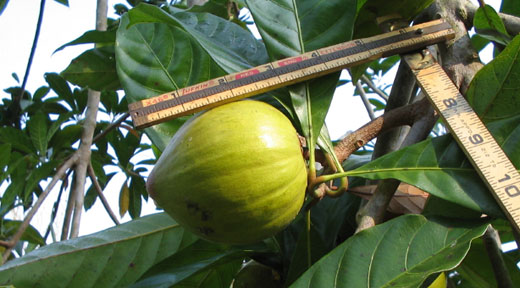
|
| Canistel - Pouteria campechiana,
aka canistel, egg fruit, Lucuma nervosa, is native to Central
America but virtually unknown in Belize except in botanical
gardens and private fruit growing enthusiasts. It is not commercially
cultivated in Belize. The color of the ripe fruits is bright yellow/orange and may be round or oblong depending on the variety but all have a point at one end. Size can vary from 2 1/2 to 5" in diameter. The flesh color is bright orange with a dry mealy to a moist consistency. It is eaten fresh and also used for pies, shakes, smoothies and ice cream. The color of the flesh and consistency often remind one of a boiled egg yolk, thus giving it a local common name - egg fruit. However, at Dem Dats Doin we promote the canistel as a sweet potato that grows on trees. This fruit from Central America was carried to Africa by missionaries. It is grown and widely accepted due to its yellow sweet potato characteristics and ease of cultivation. The canistel is very similar to a local fruit called Monkey Cap. The trees at Dem Dats Doin were grown from seeds obtained from Florida and Puerto Rico in 1983 and bore fruit in 1988. However, superior varieties are usually grafted or air layered and usually produces fruit within two years. If the fruits are allowed to ripen on the tree the fruit will develop cracks along the skin. At such a time birds will peck at the fruit and cause it to drop to the ground where the agouti, gibnut and other rodents will finish off this unusually delicious fruit. There are usually from one to three ovals, brown, hard-shelled glossy seeds about an inch-and-a-half like miniature sapote (mammey) seeds in each fruit. At Dem Dats Doin the fruits are picked when mature and kept in cool shady area to complete its ripening cycle Cultivation practice - treat like citrus; seeds germinate from 3 to 6 months; likes slightly acid well drained soil in full sun although it can tolerate alkaline soils; salt tolerance fair to good but should be protected from really exposed areas close to the sea. The fruit is easily bruised and does not ship well. At present, it is more suitable for home/garden planting then for the export market. |
||
 |
||
A Canistel measures about
3 inches. This and many more fruits and plants are found at Dem
Dats Doin, the Toledo Botanical Arborethum, near Columbia Village
in Belize's Toledo District. |
||
|

